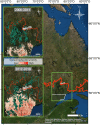Insect-mediated apparent competition between mammals in a boreal food web
- PMID: 34282006
- PMCID: PMC8325153
- DOI: 10.1073/pnas.2022892118
Insect-mediated apparent competition between mammals in a boreal food web
Abstract
While the important role of animal-mediated interactions in the top-down restructuring of plant communities is well documented, less is known of their ensuing repercussions at higher trophic levels. We demonstrate how typically decoupled ecological interactions may become intertwined such that the impact of an insect pest on forest structure and composition alters predator-prey interactions among large mammals. Specifically, we show how irruptions in a common, cyclic insect pest of the boreal forest, the spruce budworm (Choristoneura fumiferana), modulated an indirect trophic interaction by initiating a flush in deciduous vegetation that benefited moose (Alces alces), in turn strengthening apparent competition between moose and threatened boreal caribou (Rangifer tarandus caribou) via wolf (Canis lupus) predation. Critically, predation on caribou postoutbreak was exacerbated by human activity (salvage logging). We believe our observations of significant, large-scale reverberating consumer-producer-consumer interactions are likely to be common in nature.
Keywords: apparent competition; habitat selection; insect outbreaks; species conservation; species interactions.
Conflict of interest statement
The authors declare no competing interest.
Figures




References
-
- Wootton J. T., Indirect effects in complex ecosystems: Recent progress and future challenges. J. Sea Res. 48, 157–172 (2002).
-
- Ripple W. J., et al. ., Status and ecological effects of the world’s largest carnivores. Science 343, 1241484 (2014). - PubMed
-
- Holt R. D., Predation, apparent competition, and the structure of prey communities. Theor. Popul. Biol. 12, 197–29 (1977). - PubMed
-
- Holt R. D., Bonsall M. B., Apparent competition. Annu. Rev. Ecol. Evol. Syst. 48, 447–471 (2017).

